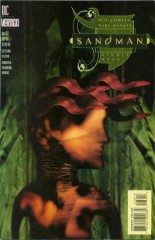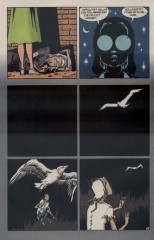Issue 63: "The Kindly Ones: 7"
Neil Gaiman, Marc Hempel
- Seventh part of storyline, The Kindly Ones
- Eighth story reprinted in trade paperback The Kindly Ones
Page 1#
Panel 1
The first panel of every issue in the main arc contains a string or cord of some kind. Here, an electrical cord.
Panel 2
Note the spots visible on the dice sum to 9, a multiple of 3.
Panel 4
The return of a main character from "A Game of You": the witch who called herself Thessaly. She was last seen in the last part of that story, issue #37.
Page 3#
Panel 2
"Larissa" is the name of a city in Greece, in the region called Thessaly.
Panel 4
A white bird such as this is a traditional symbol of the Holy Ghost.
Page 5#
Panel 1
Odin was last seen in these pages in "The Season of Mists" chapter 6, issue #27.
Page 7#
Panel 4
Or perhaps he merely felt pity for another who was pent...
Page 10#
Panel 3
This whole scene, as Delirium has noticed, echoes the scene in "Brief Lives" when Dream and Delirium consult Destiny near these statues. (Specifically 47:8-12.) Note the pathway there now resembles a backwards 6 or 9. The statues have also changed; apparently they reflect the current state of their originals.
Page 11#
Panel 4
A pun of sorts.
Page 13#
Panel 1
In issue #2 honey is among Dream's ingredients for calling the Hecateae.
Panel 6
A black lamb is another.
Page 15#
Panel 2
In Greek mythology at least, these would be Persephone, bride of Hades (and since this story takes place in winter, she would indeed be waiting beneath the earth); Demeter; and either Artemis or Hecate -- both moon goddesses. Given that this is also a maiden-mother-crone triad, Hecate seems more likely.
Panel 4
No refs on "Trivia of the Crossways" except that Dream called the Hecateae at a crossroads.
Panel 6
The book is "The Late Richard Dadd", by Patricia Allderidge. Richard Dadd was an English artist of the late nineteenth century, known for his fantastic subjects. He went mad.
Page 17#
- This page echoes Lyta's similar reflections in "The Doll's House" part 3 (12:9). Compare also 61:21.4.
Page 18#
The panel borders here are probably left white by mistake; logic suggests that they ought to be grey shading to black as they are on the next page.
Panel 1
Note the claws of brass.
Page 21#
- The panel borders here are reminiscent of Celtic designs. As is probably clear, the Morrigan is an Irish war goddess, an aspect of the Three-in-One.
Page 22#
Panels 2-4:
The damaged door lock and the wall decorations (identical to the ones seen in "The Parliament of Rooks") suggest that Daniel and the Corinthian are in Lyta Hall's LA apartment.
Page 23#
Panel 4
Well, it's clear that when the ravens leave the Tower of London, the kingdom of England is supposed to fall. No specific refs on this, however. Here it's a different kingdom that will be falling.
Credits
- Greg "elmo" Morrow (morrow@physics.rice.edu) created the Sandman Annotations.
- Originally collated and edited by David Goldfarb.
- Lance "Squiddie" Smith (lsmith@cs.umn.edu) identified Larissa's book, and the name "Larissa".
- Adam Huby (ajh@crosfield.co.uk) gave some more biographical information on Richard Dadd.
- Greg McElhatton (stu_glmcelha@vax1.acs.jmu.edu) pointed out Lyta's claws of brass.
- Katie Schwarz (katie@physics.berkeley.edu) also noted the claws, pointed out Dream's ritual from issue #2, and noticed the wall decorations.
Last modified by Richard Munn on 2023-08-15 - Updated issue inclusion blocks, adding extra trades, and audible/netflix episodes
[edit this page] [page history]













